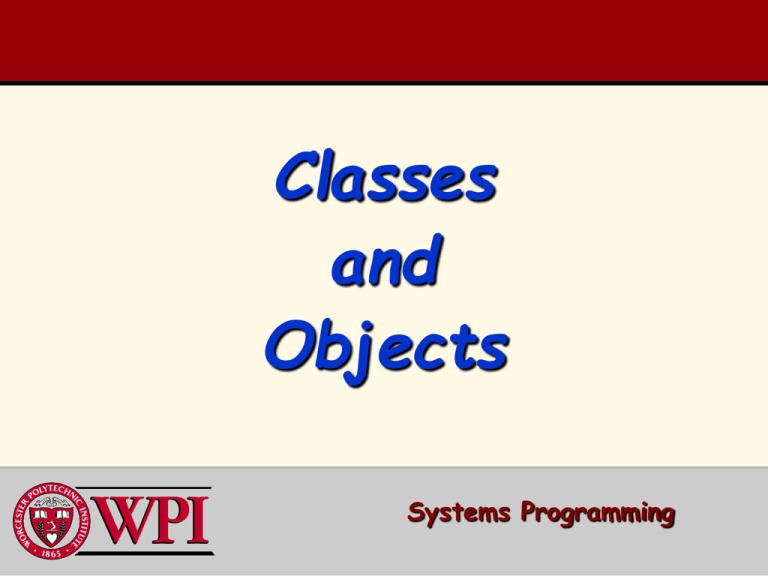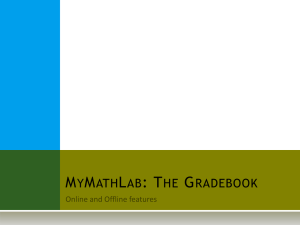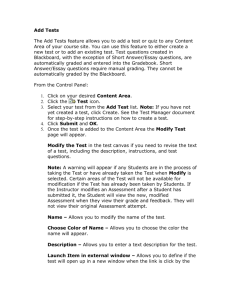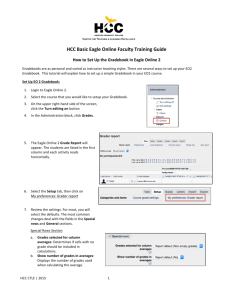
Classes
and
Objects
Systems Programming
Classes and Objects
Class Definitions and Objects
Member Functions
Data Members
– Get and Set functions
– Constructors
Placing Classes in Separate Files
Separating Interface from Implementation
Data Validation
– Ensures that data in an object is in a particular
format or range.
Systems Programming
Classes and Objects
2
C++ Program Structure
Typically C++ Programs will consist of:
– A function main
– One or more classes
• Each containing data members and member
functions.
Systems Programming
Classes and Objects
3
16.2 Defining a Class
With a Member Function
Class definition
– Tells the compiler what member functions
and data members belong to the class.
– Keyword class followed by the class’s
name.
– Class body is enclosed in braces ({})
• Specifies data members and member functions
• Access-specifier public:
– Indicates that a member function or data member is
accessible to other functions and member functions
of other classes.
Systems Programming
Classes and Objects
4
C++ Gradebook Example
1
// Fig. 19.1: fig19_01.cpp
2
// Define class GradeBook with a member function displayMessage;
3
// Create a GradeBook object and call its displayMessage function.
4
#include <iostream>
5
using std::cout;
6
using std::endl;
7
8
// GradeBook class definition
9
class GradeBook
10 {
11 public:
12
// function that displays a welcome
13
void displayMessage()
14
{
15
16
Beginning of class definition
for class GradeBook
Beginning of class body
Access specifier public; makes
members
the public
message
to theavailable
GradeBookto
user
Member function displayMessage
returns nothing.
cout << "Welcome to the Grade Book!" << endl;
} // end function displayMessage
17 }; // end class GradeBook
18
End of class body
19 // function main begins program execution
20 int main()
21 {
Use dot operator to call
GradeBook’s member function
named myGradeBook
22
GradeBook myGradeBook; // create a GradeBook object
23
myGradeBook.displayMessage(); // call object's displayMessage function
24
return 0; // indicate successful termination
25 } // end main
Welcome to the Grade Book!
Systems Programming
Classes and Objects
5
Member Function Takes a Parameter
1
// Fig. 19.3: fig19_03.cpp
2
// Define class GradeBook with a member function that takes a parameter;
3
// Create a GradeBook object and call its displayMessage function.
4
#include <iostream>
5
using std::cout;
6
using std::cin;
7
using std::endl;
Include string class
definition
8
9
#include <string> // program uses C++ standard string class
10 using std::string;
11 using std::getline;
12
Member function
parameter
13 // GradeBook class definition
14 class GradeBook
15 {
16 public:
17
// function that displays a welcome message to the GradeBook user
18
void displayMessage( string courseName )
19
{
20
21
22
cout << "Welcome to the grade book for\n" << courseName << "!"
<< endl;
} // end function displayMessage
Use the function
parameter as a
variable
23 }; // end class GradeBook
24
25 // function main begins program execution
26 int main()
27 {
28
string nameOfCourse; // string of characters to store the course name
29
GradeBook myGradeBook; // create a GradeBook object named myGradeBook
30
Systems Programming
Classes and Objects
6
Member function takes a parameter
getline is a library fcn
31
// prompt for and input course name
32
cout << "Please enter the course name:" << endl;
33
getline( cin, nameOfCourse ); // read a course name with blanks
34
cout << endl; // output a blank line
35
36
// call myGradeBook's displayMessage function
37
// and pass nameOfCourse as an argument
38
myGradeBook.displayMessage( nameOfCourse );
39
return 0; // indicate successful termination
40 } // end main
Please enter the course name:
CS101 Introduction to C++ Programming
Passing an argument to the
member function
Welcome to the grade book for
CS101 Introduction to C++ Programming!
Systems Programming
Classes and Objects
7
Member Function Takes a Parameter
A string
– Represents a string of characters.
– An object of C++ Standard Library class
std::string
• Defined in header file <string>.
Library function getline
– Used to retrieve input until a newline is
encountered.
– Example
• getline( cin, nameOfCourse );
– Inputs a line from standard input into string object
nameOfCourse.
Systems Programming
Classes and Objects
8
16.4 Data Members, set Functions and
get Functions
Local variables
– Variables declared in a function definition’s body cannot
be used outside of that function body.
– When a function terminates the values of its local
variables are lost.
Attributes
– Exist throughout the life of the object.
– Are represented as data members.
• Namely, associated with variables in a class
definition.
• Are declared inside a class definition but outside the
bodies of the class’s member-function definitions.
– Each object of a class maintains its own copy of its
attributes in memory.
Systems Programming
Classes and Objects
9
16.4 Data Members, set Functions and
get Functions
Access-specifier private
– Makes a data member or member function
accessible only to member functions of the
class.
– private is the default access for class
members.
– “information hiding” is an object-oriented
tenet.
Returning a value from a function
– A function that specifies a return type other
than void
• Returns a value to its calling function.
Systems Programming
Classes and Objects
10
16.4 Data Members, set Functions and
get Functions
1
// Fig. 19.5: fig19_05.cpp
2
3
// Define class GradeBook that contains a courseName data member
// and member functions to set and get its value;
4
// Create and manipulate a GradeBook object with these functions.
5
#include <iostream>
6
using std::cout;
7
using std::cin;
8
using std::endl;
9
10 #include <string> // program uses C++ standard string class
11 using std::string;
12 using std::getline;
13
14 // GradeBook class definition
set function modifies private
data
15 class GradeBook
16 {
17 public:
18
// function that sets the course name
19
void setCourseName( string name )
20
{
courseName = name; // store the course name in the object
21
22
} // end function setCourseName
get function accesses private
data
23
24
25
// function that gets the course name
string getCourseName()
26
{
27
28
return courseName; // return the object's courseName
} // end function getCourseName
29
Systems Programming
Classes and Objects
11
16.4 Data Members, set Functions and
get Functions
30
// function that displays a welcome message
31
void displayMessage()
32
{
33
// this statement calls getCourseName to get the
34
// name of the course this GradeBook represents
35
cout << "Welcome to the grade book for\n" << getCourseName() << "!"
<< endl;
36
37
} // end function displayMessage
38 private:
39
string courseName; // course name for this GradeBook
40 }; // end class GradeBook
41
42 // function main begins program execution
43 int main()
44 {
Use set and get functions,
even within the class
private members accessible
only to member functions of the
class
45
string nameOfCourse; // string of characters to store the course name
46
GradeBook myGradeBook; // create a GradeBook object named myGradeBook
47
48
// display initial value of courseName
49
cout << "Initial course name is: " << myGradeBook.getCourseName()
50
default constructor
Accessing private data
outside class definition
<< endl;
51
Systems Programming
Classes and Objects
12
16.4 Data Members, set Functions and
get Functions
52
// prompt for, input and set course name
53
cout << "\nPlease enter the course name:" << endl;
54
getline( cin, nameOfCourse ); // read a course name with blanks
55
myGradeBook.setCourseName( nameOfCourse ); // set the course name
56
57
cout << endl; // outputs a blank line
58
myGradeBook.displayMessage(); // display message with new course name
59
return 0; // indicate successful termination
60 } // end main
Initial course name is:
Please enter the course name:
CS101 Introduction to C++ Programming
Welcome to the grade book for
CS101 Introduction to C++ Programming!
Systems Programming
Modifying private data outside class
definition
default setting from constructor
is an empty string!!
Classes and Objects
13
Software Engineering Observation 16.1
As a rule of thumb, data members
should be declared private and
member functions should be
declared public. (We will see that it
is appropriate to declare certain
member functions private, if they
are to be accessed only by other
member functions of the class.)
Systems Programming
Classes and Objects
14
Data Members, set Functions and
get Functions
Software engineering with set and get functions:
– public member functions that allow clients of a
class to set or get the values of private data
members.
– set functions are sometimes called mutators and
get functions are sometimes called accessors.
– Allows the creator of the class to control how
clients access private data.
– Should also be used by other member functions
of the same class.
Systems Programming
Classes and Objects
15
Initializing Objects with Constructors
Constructors
– Functions used to initialize an object’s data when it is
created.
• The call is made implicitly by the compiler when the
object is created.
• Must be defined with the same name as the class.
• Cannot return values.
– Not even void !!
– A default constructor has no parameters.
• The compiler will provide one when a class does not
explicitly include a constructor.
• A compiler’s default constructor only calls
constructors of data members that are objects of
classes.
Systems Programming
Classes and Objects
16
16.5 Initializing Objects with Constructors
Any constructor that takes no arguments is called a
default constructor.
A class gets a default constructor in one of two ways:
– The compiler implicitly creates a default constructor in a class
that does not define a constructor. Such a constructor does not
initialize the class’s data members, but does call the default
constructor for each data member that is an object of another
class. An uninitialized variable typically contains a “garbage”
value.
– You explicitly define a constructor that takes no arguments.
Such a default constructor will call the default constructor for
each data member that is an object of another class and will
perform additional initialization specified by you.
If you define a constructor with arguments, C++ will not
implicitly create a default constructor for that class.
Copyright © Pearson, Inc. 2013. All Rights Reserved.
Systems Programming
Classes and Objects
17
Constructor Example
Constructor has same name
as class and no return type
Initialize data member
Copyright © Pearson, Inc. 2013. All Rights Reserved.
Systems Programming
Classes and Objects
18
Constructor Example
Copyright © Pearson, Inc. 2013. All Rights Reserved.
Systems Programming
Classes and Objects
19
Constructor Example
Creating objects implicitly calls the
constructor
Copyright © Pearson, Inc. 2013. All Rights Reserved.
Systems Programming
Classes and Objects
20
Placing a Class in a Separate File
for Reusability
.cpp file is known as a source-code file.
Header files
– Separate files in which class definitions are
placed.
– Allows compiler to recognize the classes when
used elsewhere.
– Generally have .h filename extensions
Driver files
– A program used to test software (such as
classes).
– Contains a main function so it can be executed.
Systems Programming
Classes and Objects
21
16.7 Separating Interface from
Implementation
Interface
– Describes what services a class’s clients can use and
how to request those services.
• without revealing how the class carries out the
services.
• a class definition that lists only member function
names, return types and parameter types.
– e.g., function prototypes
– A class’s interface consists of the class’s public member
functions (services).
Separating interface from implementation:
– Client code should not break if implementation changes,
as long as the interface stays the same.
Systems Programming
Classes and Objects
22
Separating Interface from Implementation
Define the member functions outside the class
definition, in a separate source-code file.
– In a source-code file for a class
• Use binary scope resolution operator (::) to
tie each member function to the class
definition.
– Implementation details are hidden.
• Client code does not need to know the
implementation.
In a header file for a class
– The function prototypes describe the class’s
public interface.
Systems Programming
Classes and Objects
23
Separating Interface from Implementation
1
// Fig. 19.11: GradeBook.h
2
// GradeBook class definition. This file presents GradeBook's public
3
// interface without revealing the implementations of GradeBook's member
4
// functions, which are defined in GradeBook.cpp.
5
#include <string> // class GradeBook uses C++ standard string class
6
using std::string;
7
8
// GradeBook class definition
9
class GradeBook
Interface contains data members and
member function prototypes
10 {
11 public:
12
GradeBook( string ); // constructor that initializes courseName
13
void setCourseName( string ); // function that sets the course name
14
string getCourseName(); // function that gets the course name
15
void displayMessage(); // function that displays a welcome message
16 private:
17
string courseName; // course name for this GradeBook
18 }; // end class GradeBook
Systems Programming
Classes and Objects
24
Separating Interface from Implementation
1
// Fig. 19.12: GradeBook.cpp
2
// GradeBook member-function definitions. This file contains
3
// implementations of the member functions prototyped in GradeBook.h.
4
#include <iostream>
5
using std::cout;
6
using std::endl;
GradeBook implementation is placed
in a separate source-code file
7
8
#include "GradeBook.h" // include definition of class GradeBook
9
Include the header file to access
the class name GradeBook
10 // constructor initializes courseName with string supplied as argument
11 GradeBook::GradeBook( string name )
12 {
13
setCourseName( name ); // call set function to initialize courseName
14 } // end GradeBook constructor
15
16 // function to set the course name
Binary scope resolution operator
ties a function to its class
17 void GradeBook::setCourseName( string name )
18 {
19
courseName = name; // store the course name in the object
20 } // end function setCourseName
21
Systems Programming
Classes and Objects
25
Separating Interface from Implementation
22 // function to get the course name
23 string GradeBook::getCourseName()
24 {
25
return courseName; // return object's courseName
26 } // end function getCourseName
27
28 // display a welcome message to the GradeBook user
29 void GradeBook::displayMessage()
30 {
31
// call getCourseName to get the courseName
32
cout << "Welcome to the grade book for\n" << getCourseName()
33
<< "!" << endl;
34 } // end function displayMessage
Systems Programming
Classes and Objects
26
Separating Interface from Implementation
1
// Fig. 19.13: fig19_13.cpp
2
// GradeBook class demonstration after separating
3
// its interface from its implementation.
4
#include <iostream>
5
using std::cout;
6
using std::endl;
Note - This is a separate .cpp
file that holds only main.
7
8
#include "GradeBook.h" // include definition of class GradeBook
9
10 // function main begins program execution
11 int main()
12 {
13
// create two GradeBook objects
14
GradeBook gradeBook1( "CS101 Introduction to C++ Programming" );
15
GradeBook gradeBook2( "CS102 Data Structures in C++" );
16
17
// display initial value of courseName for each GradeBook
18
cout << "gradeBook1 created for course: " << gradeBook1.getCourseName()
19
<< "\ngradeBook2 created for course: " << gradeBook2.getCourseName()
20
<< endl;
21
return 0; // indicate successful termination
22 } // end main
gradeBook1 created for course: CS101 Introduction to C++ Programming
gradeBook2 created for course: CS102 Data Structures in C++
Systems Programming
Classes and Objects
27
19.10 Validating Data with set
Functions
set functions can validate data.
– Known as validity checking.
– Keeps object in a consistent state.
• The data member contains a valid value.
– Can return values indicating that attempts were
made to assign invalid data.
string member functions
– length returns the number of characters in the
string.
– substr returns specified substring within the
string.
Systems Programming
Classes and Objects
28
Validating Data with set Functions
1
// Fig. 19.16: GradeBook.cpp
2
// Implementations of the GradeBook member-function definitions.
3
// The setCourseName function performs validation.
4
#include <iostream>
5
using std::cout;
6
using std::endl;
7
8
#include "GradeBook.h" // include definition of class GradeBook
9
10 // constructor initializes courseName with string supplied as argument
11 GradeBook::GradeBook( string name )
Constructor calls set function to
perform validity checking
12 {
13
setCourseName( name ); // validate and store courseName
14 } // end GradeBook constructor
15
16 // function that sets the course name;
17 // ensures that the course name has at most 25 characters
18 void GradeBook::setCourseName( string name )
set functions perform validity checking to
keep courseName in a consistent state
19 {
20
if ( name.length() <= 25 ) // if name has 25 or fewer characters
21
courseName = name; // store the course name in the object
22
Systems Programming
Classes and Objects
29
Validating Data with set Functions
23
if ( name.length() > 25 ) // if name has more than 25 characters
24
{
25
// set courseName to first 25 characters of parameter name
26
courseName = name.substr( 0, 25 ); // start at 0, length of 25
27
28
29
30
cout << "Name \"" << name << "\" exceeds maximum length (25).\n"
<< "Limiting courseName to first 25 characters.\n" << endl;
} // end if
31 } // end function setCourseName
32
33 // function to get the course name
34 string GradeBook::getCourseName()
35 {
36
return courseName; // return object's courseName
37 } // end function getCourseName
38
39 // display a welcome message to the GradeBook user
40 void GradeBook::displayMessage()
41 {
42
// call getCourseName to get the courseName
43
cout << "Welcome to the grade book for\n" << getCourseName()
44
<< "!" << endl;
45 } // end function displayMessage
Systems Programming
Classes and Objects
30
Review of Classes and Objects
Introduced class definitions and objects
– Public versus private access into class.
Syntax for member functions
Syntax data members
– Get and Set functions
– Constructors
Placing classes in separate files
Separating interface from implementation
Data validation in set functions.
Systems Programming
Classes and Objects
31





